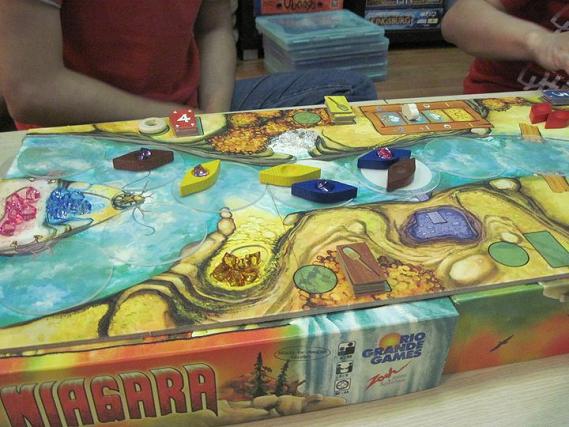
Not much to say about Niagara as it is a light family game. Or at least it’s supposed to be one, as our session turned into a protracted bout of vindictive backstabbing and thievery. I didn’t think family games could get so nasty! This time around, the implausible premise is that there are gems all along the banks of the Niagara river and you job is to navigate down the river on canoes to snag them while being careful not to fall over the edge of the waterfall. Naturally, this is easier said than done as the river’s current will constantly bring you closer to the edge.
I guess the main appeal of this game is the gimmick of using clear plastic discs to represent the flow of the river’s current. The river is forked and filled with the discs. At the end of each turn, a certain number of discs are inserted at the far end of the river, which will push the discs downstream until they fall off the edge, together with any canoes on them. Thanks to the way the board is set up, the discs that fall off will alternate between the ends of the fork, giving players a bit more to think about to avoid their canoes falling off.
Gameplay-wise, Niagara uses the familiar mechanic of having each player secretly choose a paddle tile each turn and reveal the choice simultaneously. These tiles depict either a number that represents how many spaces your canoes can move or a cloud symbol that allows you to manipulate the weather track. Once you use a tile it’s unavailable until you have exhausted all of your tiles. The movement points can be spent when you’re adjacent to a spot with gems to pick one up. Also, if you’re moving upstream and your canoe is empty and you just happen to stop in the same space as another canoe carrying a gem, you get to steal that gem. Once everyone has moved, the river then flows a number of spaces equal to the lowest numbered tile played modified by the weather track. The first player to get either one of each gem, four of one gem type or a total of seven gems wins the game.

Some notes:
- It’s much easier to steal the gems that are right on the edge of the map from someone else than actually go right up to the edge to take them yourself. Naturally, this led to a lot of thievery.
- The weather track goes from -1 to +2 but you wouldn’t know it from our session. It was almost constantly on the +2 space. Stronger currents equals more canoes going over the waterfall equals more laughs all round.
- Due to the above two reasons, we had a hard time collecting enough gems to complete the game. Between the constant thefts and gem payments to replace lost canoes, this game went on for a lot longer than anyone expected.
- To get an idea on how much time we spent on this, Aaron went down to zero boats and zero gems, giving him a free boat and then accumulated enough gems to be in the running again.
- As usual I had some trouble differentiating between the colors of the gems. Unusually, I wasn’t the only one with color problems this time around.
Overall, while not being an exceptional game, Niagara does score points for the creative way it uses plastic discs to represent a flowing river and it’s rare to see a family game that’s quite so nasty.
One Response to “Niagara”
Trackbacks
Leave a Reply